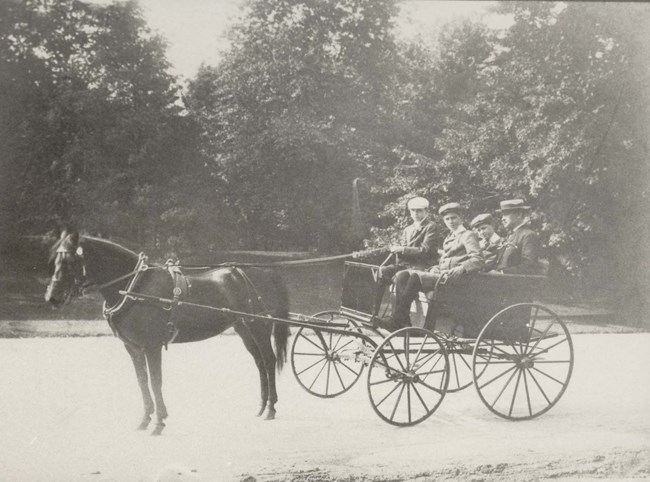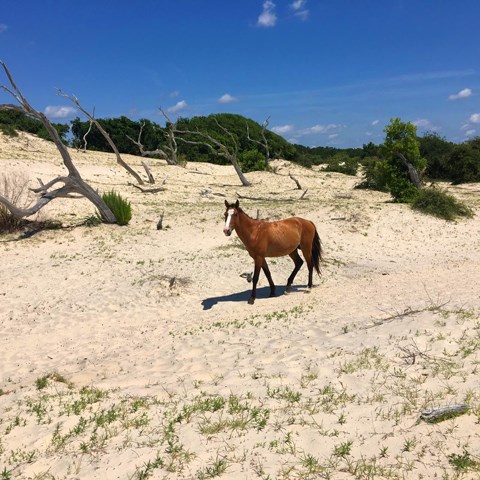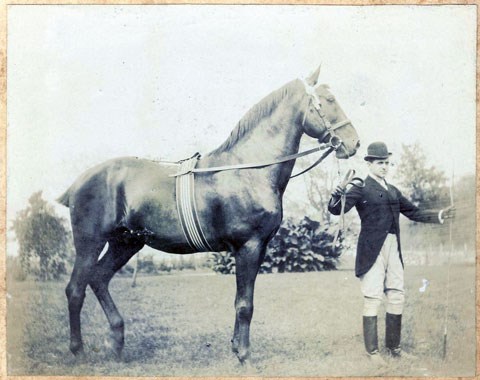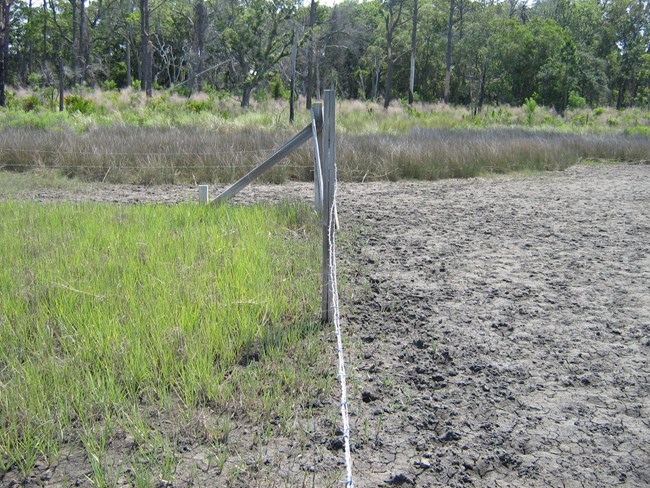
NPS Photo 
NPS Photo History on the IslandA few horses were probably brought to Cumberland as livestock when Spanish missions were established in the late 1500s although evidence is scarce.
The earliest historic account of horses on Cumberland Island was in 1742. During the battle between the Spanish and the English over Fort St. Andrews on the north end of Cumberland, the Spanish found “fifty to sixty horses in a corral within the fort.” By the end of the 1700s, island landowners were reporting an estimate of 200 domestic horses and some mules kept as free ranging livestock on Cumberland. During the early 1800s, several plantations were in operation on the island and horses played an integral role in transportation, work and recreation. In the turmoil during and after the Civil War, most of the horses were sold or otherwise removed from the island. When the Carnegie family moved to Cumberland in the 1880s, they brought horses for pulling carriages, riding, hunting and other recreational activities. Over 50 horses were stabled at Dungeness alone. Throughout the 1900s, new stock was introduced and some horses were taken off the island for sale. Property owners on Cumberland managed horses as free ranging livestock from the 1940s until the 1960s. By the time the park was established in 1972, horses had become feral on the island. What is a Feral Horse?A feral animal is an animal that was once domesticated, but has reverted to a wild state and adjusted to surviving in a natural environment without help or support of any kind from humans. During their history on the island horses have been managed as both free-ranging and corralled livestock. By the mid-1900s horses were roaming the island with little or no care provided from island residents. 
Copyright N. Wilson Non-NativesCumberland’s horses are considered non-native. A non-native animal (or plant) is any species that occurs outside its native range as a result of deliberate or accidental introduction by humans or other natural causes. Non-natives compete with native species for habitat and food. They are capable of taking over ecosystems that plants or animals need to survive. Often, non-native species will not have natural predators, so their numbers grow unchecked. 
NPS Photo Breeds/GeneticsThe horses that inhabit Cumberland Island today have descended from modern, domestic breeds. Genetic studies conducted in 1991 by the University of Georgia and University of Kentucky on the island’s population showed that Cumberland’s horses are closely related to Tennessee Walkers, American Quarter Horses, Arabians, and Paso Fino. Historic accounts support these findings, and also mention the introduction of American Mustangs, burrows, retired circus horses, and other specially purchased animals. PopulationThe National Park Service has conducted population surveys since 2003 that have returned counts ranging from 120 to 148 horses a year. These numbers are not considered a total count of all horses present, but rather they are a measure of abundance. The total number of horses on the island could be 30 to 40 animals higher than the annual survey results. Cumberland has the only herd of feral horses on the Atlantic coast that is not managed (no food, water, veterinary care, or population control). The herd is affected by all the natural stressors faced by native wildlife. The lifespan of horses on the island may be as long as 9 to 10 years. Causes of mortality include high parasite loads, drought-related stress, age, natural accidents, and suspected eastern equine encephalitis and West Nile virus. 
NPS Photo Ecology and ImpactLike any livestock, horses require large amounts of forage and fresh water. Horses are often seen grazing in the salt marsh, dune meadows, fallow fields, and historic lawns. They consume grasses, sedges, sea oats, and cordgrass. Fresh water can be found in springs and some ponds along the length of the island. Horses are large animals that can impact the areas they graze by trampling and removing native vegetation. The horse herd on Cumberland likely consumes between 200 to 400 tons of vegetation each year, removing up to 98% of it in areas they frequent. This impact can cause damage to island resources by destabilizing dunes and streambanks, selectively removing native grasses and forbs, and threatening the biodiversity of native plants and wildlife. The island is home to numerous historic structures and archeological sites some of which have also been impacted by effects of the horse population. SafetyCumberland visitors have been injured by horses in the past, usually in the form of kicks, bites, and being knocked down. These are big, powerful animals. Give them a lot of respect and maintain a distance of at least 50 feet. Do not approach a horse. If a horse feels that you are too close it may kick, bite, or charge. A good rule is if a horse changes what it is doing because you are there, then you are too close. Remember that horses have the right-of-way. If a horse approaches you, move out of its path and try to put a tree, picnic table, or other large object between you and it. Never try to feed or pet the horses. If a horse begins to associate people with food it can lead to a horse becoming dependent on support. This can be bad for both visitors and horses. 
NPS Photo |
Last updated: June 25, 2021
